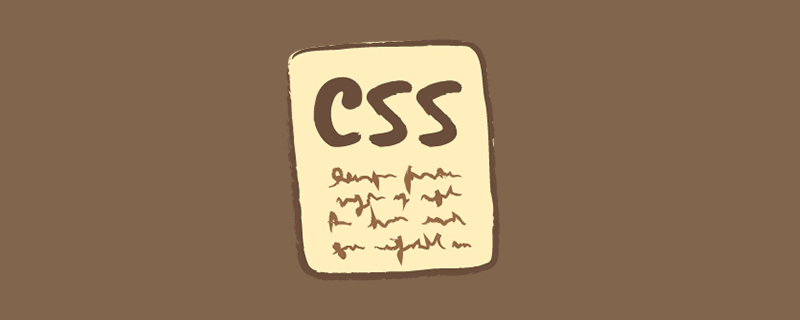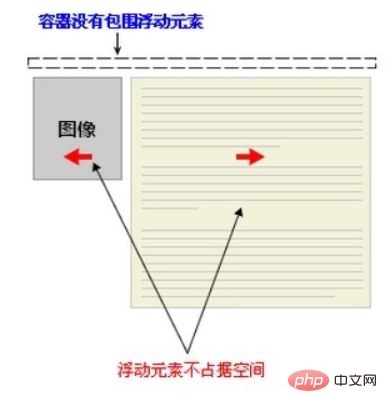What attribute is used to clear float in css
There are two types of attributes used to clear floats in css: 1. The clear attribute can define which side of the element is not allowed to float. It is usually written as "clear: both;" which means that neither side of the element is allowed to float. , which clears the float. 2. Overflow attribute, defining the "overflow:hidden;" style for the parent element can also clear floating.

The operating environment of this tutorial: Windows 7 system, CSS3&&HTML5 version, Dell G3 computer.
What is CSS clear float?
In non-IE browsers (such as Firefox), when the height of the container is auto and there are floating (float is left or right) elements in the container content, in this case In this case, the height of the container cannot automatically extend to adapt to the height of the content, causing the content to overflow outside the container and affect (or even destroy) the layout. This phenomenon is called float overflow, and the CSS processing performed to prevent this phenomenon is called CSS clear float.
Quoting the W3C example, the news container does not surround floating elements.
.news {
background-color: gray;
border: solid 1px black;
}
.news img {
float: left;
}
.news p {
float: right;
}
<div>
<img src="/static/imghw/default1.png" data-src="news-pic.jpg" class="lazy" alt="What attribute is used to clear float in css" >
<p>some text</p>
</div>
Clear floating method
Method 1: Use an empty element with clear attribute
Use an empty element after the floating element such as
, and assign .clear{clear:both;} in CSS Properties can be used to clear floats. You can also use
or
to clean.
.news {
background-color: gray;
border: solid 1px black;
}
.news img {
float: left;
}
.news p {
float: right;
}
.clear {
clear: both;
}
<div>
<img src="/static/imghw/default1.png" data-src="news-pic.jpg" class="lazy" alt="What attribute is used to clear float in css" >
<p>some text</p>
<div></div>
</div>Advantages: simple, less code, good browser compatibility.
Disadvantages: A large number of unsemantic html elements need to be added, the code is not elegant enough, and it is not easy to maintain later.
Method 2: Use the overflow attribute of CSS
Add overflow:hidden; or overflow:auto; to the container of the floating element to clear the float. In addition, in IE6 HasLayout needs to be triggered, such as setting the container width and height for the parent element or setting zoom:1.
After adding the overflow attribute, the floating element returns to the container layer, raising the height of the container, achieving the effect of cleaning up the floating elements.
.news {
background-color: gray;
border: solid 1px black;
overflow: hidden; *zoom: 1;
}
.news img {
float: left;
}
.news p {
float: right;
}
<div>
<img src="/static/imghw/default1.png" data-src="news-pic.jpg" class="lazy" alt="What attribute is used to clear float in css" >
<p>some text</p>
</div>Method 3: Add floats to the container of floating elements
Add the floating attribute to the container of floating elements to clear the internal floats, but this will cause It floats as a whole and affects the layout, so it is not recommended.
Method 4: Use adjacent element processing
Do nothing and add the clear attribute to the element behind the floating element.
.news {
background-color: gray;
border: solid 1px black;
}
.news img {
float: left;
}
.news p {
float: right;
}
.content{
clear:both;
}
<div>
<img src="/static/imghw/default1.png" data-src="news-pic.jpg" class="lazy" alt="What attribute is used to clear float in css" >
<p>some text</p>
<div></div>
</div>Method Five: Use CSS:after pseudo-element
Combined with:after pseudo-element (note that this is not a pseudo-class, but a pseudo-element, which represents after an element Recent elements) and IEhack, which are perfectly compatible with all major current mainstream browsers. IEhack here refers to triggering hasLayout.
Add a clearfix class to the container of the floating element, and then add a :after pseudo-element to this class to add an invisible block element (Block element) to the end of the element to clean up the float.
.news {
background-color: gray;
border: solid 1px black;
}
.news img {
float: left;
}
.news p {
float: right;
}
.clearfix:after{
content: "020";
display: block;
height: 0;
clear: both;
visibility: hidden;
}
.clearfix {
/* 触发 hasLayout */
zoom: 1;
}
<div>
<img src="/static/imghw/default1.png" data-src="news-pic.jpg" class="lazy" alt="What attribute is used to clear float in css" >
<p>some text</p>
</div>Add an invisible space "020" or dot "." at the end of the internal element of the container through CSS pseudo-elements, and assign the clear attribute to clear the float. It should be noted that for IE6 and IE7 browsers, a zoom:1; must be added to the clearfix class to trigger haslayout.
Summary
Through the above example, we can easily find that the methods of clearing floats can be divided into two categories:
One It uses the clear attribute, including adding an empty div with the clear: both attribute at the end of the floating element to close the element. In fact, the method of using the :after pseudo-element is to add a dot with the content at the end of the element and the clear: both attribute. implemented by the elements.
The second is to trigger the BFC (Block Formatting Contexts, block-level formatting context) of the parent element of the floating element, so that the parent element can contain floating elements. Regarding this point.
(Learning video sharing: css video tutorial, web front-end)
The above is the detailed content of What attribute is used to clear float in css. For more information, please follow other related articles on the PHP Chinese website!

Hot AI Tools

Undresser.AI Undress
AI-powered app for creating realistic nude photos

AI Clothes Remover
Online AI tool for removing clothes from photos.

Undress AI Tool
Undress images for free

Clothoff.io
AI clothes remover

AI Hentai Generator
Generate AI Hentai for free.

Hot Article

Hot Tools

Notepad++7.3.1
Easy-to-use and free code editor

SublimeText3 Chinese version
Chinese version, very easy to use

Zend Studio 13.0.1
Powerful PHP integrated development environment

Dreamweaver CS6
Visual web development tools

SublimeText3 Mac version
God-level code editing software (SublimeText3)

Hot Topics
 1378
1378
 52
52
 How to write split lines on bootstrap
Apr 07, 2025 pm 03:12 PM
How to write split lines on bootstrap
Apr 07, 2025 pm 03:12 PM
There are two ways to create a Bootstrap split line: using the tag, which creates a horizontal split line. Use the CSS border property to create custom style split lines.
 How to insert pictures on bootstrap
Apr 07, 2025 pm 03:30 PM
How to insert pictures on bootstrap
Apr 07, 2025 pm 03:30 PM
There are several ways to insert images in Bootstrap: insert images directly, using the HTML img tag. With the Bootstrap image component, you can provide responsive images and more styles. Set the image size, use the img-fluid class to make the image adaptable. Set the border, using the img-bordered class. Set the rounded corners and use the img-rounded class. Set the shadow, use the shadow class. Resize and position the image, using CSS style. Using the background image, use the background-image CSS property.
 How to resize bootstrap
Apr 07, 2025 pm 03:18 PM
How to resize bootstrap
Apr 07, 2025 pm 03:18 PM
To adjust the size of elements in Bootstrap, you can use the dimension class, which includes: adjusting width: .col-, .w-, .mw-adjust height: .h-, .min-h-, .max-h-
 The Roles of HTML, CSS, and JavaScript: Core Responsibilities
Apr 08, 2025 pm 07:05 PM
The Roles of HTML, CSS, and JavaScript: Core Responsibilities
Apr 08, 2025 pm 07:05 PM
HTML defines the web structure, CSS is responsible for style and layout, and JavaScript gives dynamic interaction. The three perform their duties in web development and jointly build a colorful website.
 How to set up the framework for bootstrap
Apr 07, 2025 pm 03:27 PM
How to set up the framework for bootstrap
Apr 07, 2025 pm 03:27 PM
To set up the Bootstrap framework, you need to follow these steps: 1. Reference the Bootstrap file via CDN; 2. Download and host the file on your own server; 3. Include the Bootstrap file in HTML; 4. Compile Sass/Less as needed; 5. Import a custom file (optional). Once setup is complete, you can use Bootstrap's grid systems, components, and styles to create responsive websites and applications.
 How to use bootstrap button
Apr 07, 2025 pm 03:09 PM
How to use bootstrap button
Apr 07, 2025 pm 03:09 PM
How to use the Bootstrap button? Introduce Bootstrap CSS to create button elements and add Bootstrap button class to add button text
 How to view the date of bootstrap
Apr 07, 2025 pm 03:03 PM
How to view the date of bootstrap
Apr 07, 2025 pm 03:03 PM
Answer: You can use the date picker component of Bootstrap to view dates in the page. Steps: Introduce the Bootstrap framework. Create a date selector input box in HTML. Bootstrap will automatically add styles to the selector. Use JavaScript to get the selected date.
 How to use bootstrap in vue
Apr 07, 2025 pm 11:33 PM
How to use bootstrap in vue
Apr 07, 2025 pm 11:33 PM
Using Bootstrap in Vue.js is divided into five steps: Install Bootstrap. Import Bootstrap in main.js. Use the Bootstrap component directly in the template. Optional: Custom style. Optional: Use plug-ins.




